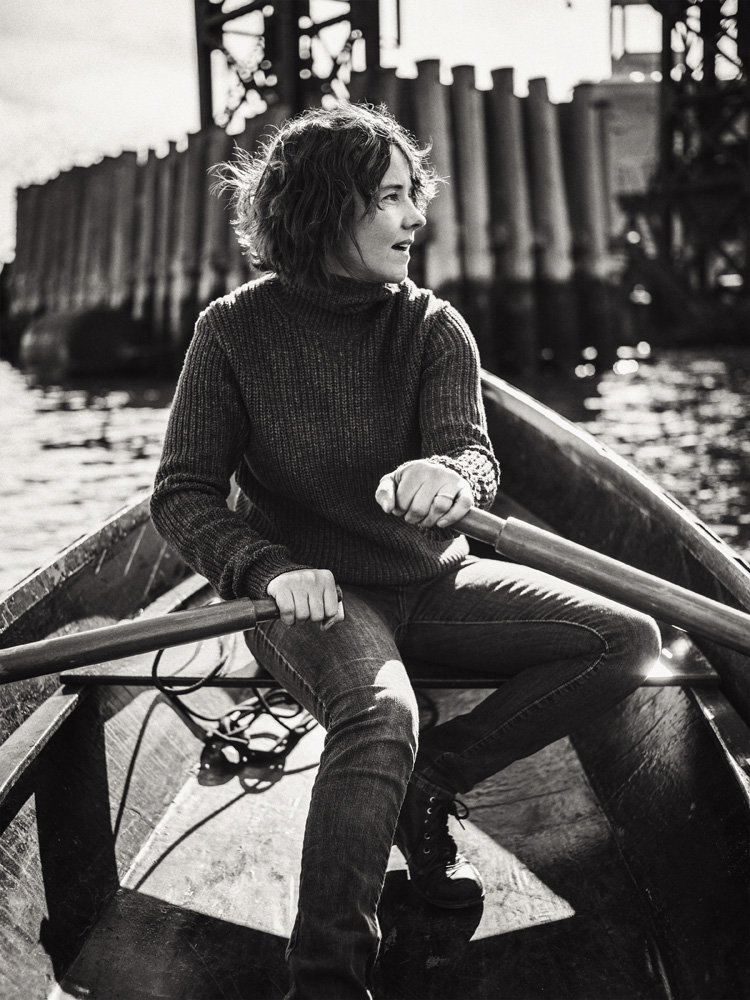Marie Lorenz
For the past nine years, Marie Lorenz has been forging one of the most ambitious, out-of-studio artistic series ever to be launched in New York. Since 2005, the 41-year-old Lorenz has been navigating New York Harbor in her handmade plywood-and-fiberglass boat, taking friends, artists, and willing participants on nautical odysseys of the city’s rivers and islands. The project, Tide and Current Taxi, which sails this month around Randall’s Island, timed to the Frieze New York art fair, has its roots in multiple artistic practices—from traditional Romantic seascape and marine painting to more radical iterations of performance art, happenings, and relational aesthetics. Lorenz has achieved the rare position of being able to create outside of gallery or studio walls, without limiting her content to commentaries or critiques of the system she’s managed to escape. Of course, it helps that the Brooklyn-based artist, who could command a boat by the age of 6, is an adventurer at heart—the kind of avant-garde pioneer more often found on Manhattan’s dry land than in its surrounding waters. Lorenz has extensive knowledge of the city’s waterways. “When I got to New York, I realized that the tides were significant,” she says. “I started looking into it, and one of my main sources is the map in the Eldridge Tide and Pilot Book that shows, at hour intervals, exactly what the tide is doing—which direction and how fast. I cross-reference that with a high-tide table so that I can tell, for example, that on May 1 at 3 p.m., the tide will be flowing north at three knots on the East River.” Lorenz uses the tides like a motor to propel her boat, as well as the time-trusted manual labor of paddling. She usually sits at the stern, with passengers facing forward at the bow and in the middle. Lorenz has experienced plenty of danger: During one of her first outings, her boat sank mid-river, near the 59th Street Bridge, and she had to swim to Roosevelt Island; in a separate endeavor, Lorenz tried to launch a boat into the Tyrrhenian Sea in Italy, only to capsize in rough water and swim to shore (a 2010 video of her desperate, breathless self-rescue became a mesmerizing art piece of its own—a sort of Bruce Nauman-esque piece on the nature of human survival). But more often than not, Lorenz’s boating field trips are more about discovery and visual disorientation than melodrama.
“The bay is your backyard in New York, and you can use it legally,” the artist explains. “You don’t need any special license to operate a rowboat. The conundrum about New York City is that you have all this open space you can use, but almost nowhere or no way to get to it.” Lorenz’s urban expeditions often involve collecting trash and refuse found in the water and on outlying islands, which she photographs for her blog or takes back to her studio to turn into sculptures or material for printmaking. (“It’s like shopping for art materials when I’m out there,” she says. “I love the way the tide reorganizes things—like putting a pair of underwear next to a bottle.”) The boat trips themselves are often captured on video by a waterproof digital camera fixed to a metal pole jutting up from the stern. The camera’s eye is in the position of fellow traveler or a Charon-like ferryman through the derelict metropolis. Perhaps what is most arresting about her work is the way it destabilizes our usual perception of the city itself—specifically the hypnotic rocking of the Manhattan skyline. “You usually see the city on solid ground,” Lorenz says. “I think when you’re floating, you see differently, your vision expands. You get to see the city from an in-between zone.” In her utilization of both the natural environment and the scrap materials of an industrial wasteland, Lorenz’s investigations are comparable to the work of Gordon Matta-Clark and Robert Smithson. But one thing Lorenz’s work shouldn’t be mistaken for is a knee-jerk nostalgia for nature or an invective against pollution. “I wouldn’t do this project if I were living in Maine,” she says. “This is where I want to be, in this fraught, garbage-y zone. I like to reanimate the stuff that has been thrown away or forgotten or washed back ashore. For a long time I was in this quandary—do I want it to be cleaned up? Not necessarily. I am showing how trashed the coastline is, but I’m attracted to it as I am the abandoned buildings and broken piers and sunken ships. I kind of like all the junk.”







